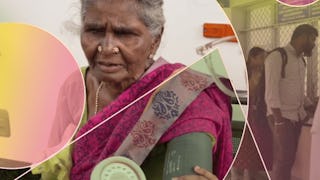Cardiovascular diseases are – according to the (World Health Organization (WHO) – the number one cause of death globally. Myocardial infarction (heart attack) is the most prominent under the Cardiovascular diseases. In Switzerland alone, the risk to develop a coronary heart disease during life time is around 25% for men and 18% for women.

Gain next-level skills with Coursera Plus for $199 (regularly $399). Save now.

(467 reviews)
Skills you'll gain
Details to know

Add to your LinkedIn profile
27 assignments
See how employees at top companies are mastering in-demand skills

There are 5 modules in this course
This first module of this course focuses on the heart and the cardiovascular system. The first lecture covers the anatomy and function of the heart, explaining the basic glossary which you will encounter during this course. The second lecture displays the various types of blood vessels and arteries. This is helpful to understand the final lecture of this module: the sympathetic nervous system. This lecture will discuss the external influences that have a direct impact on our nervous system, including the physiological effects and clinical consequences.
What's included
3 videos1 reading4 assignments1 discussion prompt
Whereas the first module focuses on different physiological aspects of the heart and the cardiovascular system, the second module considers several external risk factors which can cause a myocardial infarction. This module not only discusses the risks such as aging, smoking, hypertension, lipids and diabetes, but also explains which preventive measures can be employed to minimize the risk of a heart attack, for example, by focusing on physical exercise to increase life expectancy and the personal health.
What's included
8 videos5 readings7 assignments
This module focuses on different methods and approaches to deal with acute coronary syndrome, which in the worst case can lead to an acute heart attack. To provide you with a clearer idea of what can lead to myocardial infarction, this module concentrates on a variety of specific cardiac diseases, their mechanisms, the medical tools used to detect them, as well as on the appropriate therapeutic approach to prevent cardiac events.
What's included
6 videos3 readings7 assignments
Module four illustrates the methods employed to improve cardiac rehabilitation. Moreover, this module focuses on the secondary prevention to avoid the risk of myocardial infarction. This involves the analysis of external and biological factors which can cause cardiac diseases and explains the mechanisms needed to change bad behavioral patterns. There are several factors in life which can be easily altered to improve the personal wellbeing and those are discussed in this section.
What's included
3 videos3 readings3 assignments
The last module focuses on the pathophysiological aspect of heart diseases by illustrating the chain of cause of heart failure. The module also explains how we can diagnose a potential heart failure by correctly analyzing the clinical symptoms and signs. Echocardiography is the most important tool to identify the condition of the heart and to diagnose heart failure. To minimize the risk of heart failure, it is important to inform the patients about possible therapeutic approaches. Therefore, the last part of this module discusses both medical and device therapies and introduces assist devices in correlation with transplantation as last possible treatment method.
What's included
5 videos4 readings6 assignments
Instructor

Offered by
Explore more from Patient Care
 Status: Free
Status: FreeUniversity of Copenhagen
 Status: Free Trial
Status: Free Trial Status: Free Trial
Status: Free Trial Status: Free Trial
Status: Free TrialImperial College London
Why people choose Coursera for their career




Learner reviews
467 reviews
- 5 stars
84.79%
- 4 stars
11.77%
- 3 stars
2.35%
- 2 stars
0.64%
- 1 star
0.42%
Showing 3 of 467
Reviewed on Jan 9, 2022
this course was contained the most benificial information about Myocardial Infarction to me
Reviewed on Apr 28, 2022
The course was really effective. It's just that the formatting of the quizzes needs sme adjustment.
Reviewed on Feb 14, 2020
This course is very helpful for Medical and biological sciences people. The layout of the course is very interactive and easy to understand. Thanks, Coursera
Frequently asked questions
To access the course materials, assignments and to earn a Certificate, you will need to purchase the Certificate experience when you enroll in a course. You can try a Free Trial instead, or apply for Financial Aid. The course may offer 'Full Course, No Certificate' instead. This option lets you see all course materials, submit required assessments, and get a final grade. This also means that you will not be able to purchase a Certificate experience.
When you purchase a Certificate you get access to all course materials, including graded assignments. Upon completing the course, your electronic Certificate will be added to your Accomplishments page - from there, you can print your Certificate or add it to your LinkedIn profile.
Yes. In select learning programs, you can apply for financial aid or a scholarship if you can’t afford the enrollment fee. If fin aid or scholarship is available for your learning program selection, you’ll find a link to apply on the description page.
More questions
Financial aid available,





